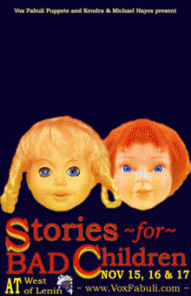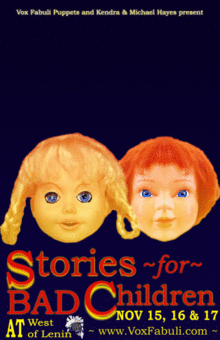 West of Lenin, a promising space hosting scrappy, uneven productions on the Fre-Lard end of N. 36th St. is at it again with their brief run of Stories for Bad Children (which closed Saturday). The structure of this vaudeville works hard to deliver strong concepts but the content mostly fails to deliver.
West of Lenin, a promising space hosting scrappy, uneven productions on the Fre-Lard end of N. 36th St. is at it again with their brief run of Stories for Bad Children (which closed Saturday). The structure of this vaudeville works hard to deliver strong concepts but the content mostly fails to deliver.
The frame for these shows plays on the audience relationship with the performance. Ron Darling’s set invites us into a living-room sleepover-tent of patchwork cloth with framed scrims and a pile of pillows. Hans, the evening’s host (Dartanion London), perforates the safety of the proscenium staging with an affected engagement of the audience.
Even the benign act of selecting the running order by choice of Bob Koerner’s giant tarot cards raises hackles and the audience’s willingness to play along quickly diminishes. London is more successful in resorting to bribery to instigate a post-intermission pillow-fight (which, in a less-regimented seating arrangement, and with more pillows, might have engaged the entire audience).
As for the performances themselves they are broken into two rounds across the intermission with each act performing twice. Some of the acts feel artificially broken up. Other second acts feel redundant. The strongest pieces in the evening depend on language for their success.
The musical act is Rick Miller, who plays highly verbal acoustic-electric folk rock. His opening number, “For the Naughty Children,” is the stronger of his pieces supported by smart fretwork and steady strumming with some picked highlights. Composition and performance are weaker in his second act number.
While Miller’s music is fine it recommends itself to focused listening that engages more intellectually than emotionally. This works against the prevailing inclination of the production as a whole. Hans would have been more effective with the support and inclusion of live music that emphasized melody and rhythm over language.
Basil Harris performs further feats of phraseology with a pair of stories by Kelleen Conway Blanchard. Here too the first act is the stronger piece as Harris adopts a hick accent for Real Love, a tale that is as charming as it is disturbing. The second piece, Lord Percival, is a kind of Tennessee-Williams noir that’s more tiresome. Harris’s costuming is brilliant evoking the characters while maintaining the evening’s aesthetic, first in a union suit and later with a kimono in which he becomes Tennessee Williams as Blanche Dubois down to the accent and crowd-pleasing coughing laugh.
The dance elements are the weakest pieces in the evening including the Mer Sedna dance ‘Fairest’ – the dark tale of Snow White. This mildly gothic vengeful take on the conflict between Snow White and her wicked witch step-mother does little more than play the most fundamental actions of the plot. Collaborators Katrina Ellison and Victoria Jacobs deliver these actions with a filigree of butoh-paced belly dance undulations. It’s pretty, declarative, and empty.
The other dance act, Confessions of a Houseplant, features Kendra Hayes in green with fake foliage accessories dancing a kind of fluid half-hearted bone-breaking shuffle. There is little skill or art in this dance. It mostly serves to tell a barely amusing joke. In its second iteration the dance gains a modicum of substance by grappling on to Sann Hall and Rachel Jackson’s (aka Vox Fabuli Puppets) success with The Hansel and Gretel Variations.
Hall and Jackson’s puppet show is rough to say the least. Coarse hand puppets and plastic dolls play most of the characters. The finest sculptural work is a surprise set element and even that feels very cut and pasted. This is all in keeping with the nursery world of the evening and the prevailing strength of the textual aspects of the performances.
The recorded narration of these variations feels cheap in the quality of both recording and editing but the words carry the audience and the psychological distance of its artifice is engaging. The first round of variations is contemporarily snarky and full of socially smart commentary. The family’s poverty is blamed on the great recession. The father is good-hearted, weak and bumbling. The stepmother, played by a Barbie doll, is gleefully destroyed in a variety of ways. Hall and Jackson emphasize and elaborate on the violence that is too often bowdlerized out of traditional tales. The sum of this remixing is a revealing and engaging work that entertains and enlightens. In the second iteration they build further still and do it in rhyming couplets that often feel as rough as the puppets.
The Hansel and Gretel Variations has excellent bones. One wonders how enhanced production values would change the show. Is the recorded narration important to its success? Hall and Jackson perform fully visible, dressed in the Stories for Bad Children uniform of pajamas. The puppeteers’ expressions and shifting degrees of emotional commitment serve as psychological surrogates or subtitles for the expressionless puppets. Would more nuanced puppets require better masking of the puppeteers and would that diminish the efficacy of the performance? With any luck we will have further opportunities to share in this experiment. Hopefully those future experiments will have better company.
